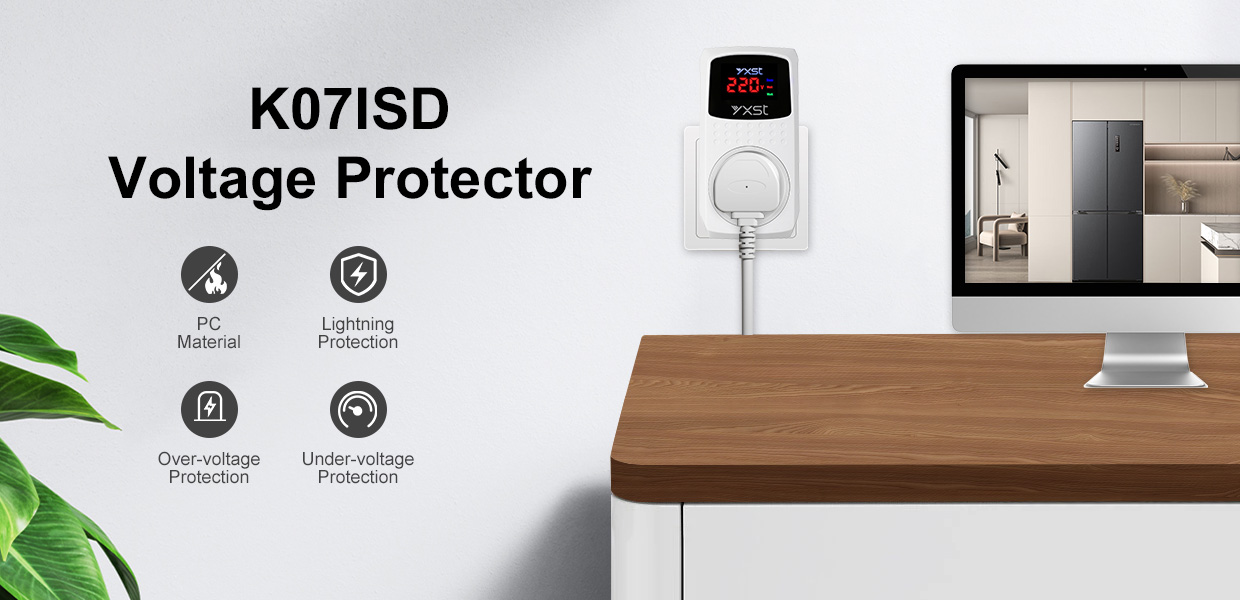How to choose a suitable voltage protector?
Rated voltage and current:
Make sure the rated voltage range of the voltage protector matches your home power system. Usually, the rated voltage of a home voltage protector is 120V or 240V, which is suitable for most residences.
Withstand voltage (rated discharge current):
The withstand voltage of a voltage protector is usually measured in terms of rated discharge current (In), which is measured in kiloamperes (kA). This value indicates the maximum current that the voltage protector can handle in a single voltage surge event. Generally speaking, the higher the withstand voltage, the stronger the protection capability.
Response time:
The shorter the response time of the voltage protector, the better, because it can respond to voltage surges faster and protect the equipment. The typical response time should be at the nanosecond level.
Working mode:
The voltage protector can be instantaneous (for single device protection) or integral (for the protection of the entire electrical system). For home use, an integral voltage protector is generally selected and installed on the main electrical panel to protect the equipment of the entire home.
Certification and standards:
Choose a voltage protector that meets international or local standards, such as UL standards. This ensures they have passed relevant safety and performance tests.
Warranty and Service:
Learn about the warranty policy and after-sales service of the voltage protector so that you can get support and repairs when needed.
Installation Requirements:
Consider the installation requirements and complexity of the voltage protector to ensure it can work effectively in your home’s electrical system and comply with local electrical safety regulations.

how to install a voltage protector in your house?
Choose the Right Surge Protector:
Select a whole-house surge protector that is suitable for your electrical panel and meets your home’s voltage requirements.
Turn Off Power:
Before starting any electrical work, turn off the main power to your home. This ensures safety and prevents electrical shocks.
Mount Surge Protector:
Surge protectors are typically installed near the main breaker panel. Some models may need to be mounted directly onto the panel, while others may require mounting on a nearby wall or surface.
Connect Surge Protector:
Follow the manufacturer’s instructions for wiring the surge protector. If you’re unsure, consider hiring a licensed electrician to ensure proper installation.
Grounding:
Proper grounding is essential for surge protectors to function effectively. Ensure that the surge protector is properly grounded according to local electrical codes.
Test and Restore Power:
Once the surge protector is securely installed and connected, restore power to your home. Test the surge protector to ensure it is functioning correctly by checking its indicator lights or testing outlets protected by the device.
Consider Additional Protection:
While a whole-house surge protector provides broad protection, consider using individual surge protectors for sensitive electronic devices inside your home for added security.
Regular Maintenance:
Periodically check the surge protector for any signs of wear or damage. Surge protectors can wear out over time due to repeated surges, so they may need replacement after a severe surge event.

How often do I need to replace a voltage protector?
Lightning strike frequency and voltage surges: If your area has a high frequency of lightning strikes or frequent voltage surges in the power grid, the voltage protector may work more frequently, shortening its life.
Installation location: The voltage protector is installed on the main electrical panel and directly receives overvoltages from the power grid. Therefore, if the overvoltage in the power grid is more frequent or stronger, the protector may be affected more quickly.
Quality and brand: High-quality voltage protectors usually have a longer service life and can withstand more voltage shocks without failure.
Working conditions: If the voltage protector is overloaded or frequently works close to its maximum withstand voltage capacity, its life may be shortened.

As a general rule of thumb, under normal use and environmental conditions, the voltage protector may last for many years or even more than ten years without replacement.
To ensure that it continues to effectively protect electrical equipment, it is recommended to regularly check and test the status of the voltage protector. This can be done by a professional electrical engineer or a qualified installer who can use suitable test equipment to evaluate the working status and protection performance of the voltage protector.
This article is summarized by the voltage protector factory. How to choose a suitable voltage protector? How to install a voltage protector at home? How often do you need to replace a voltage protector? Warm reminder, regular inspection and testing are the keys to keeping the voltage protector working effectively.




